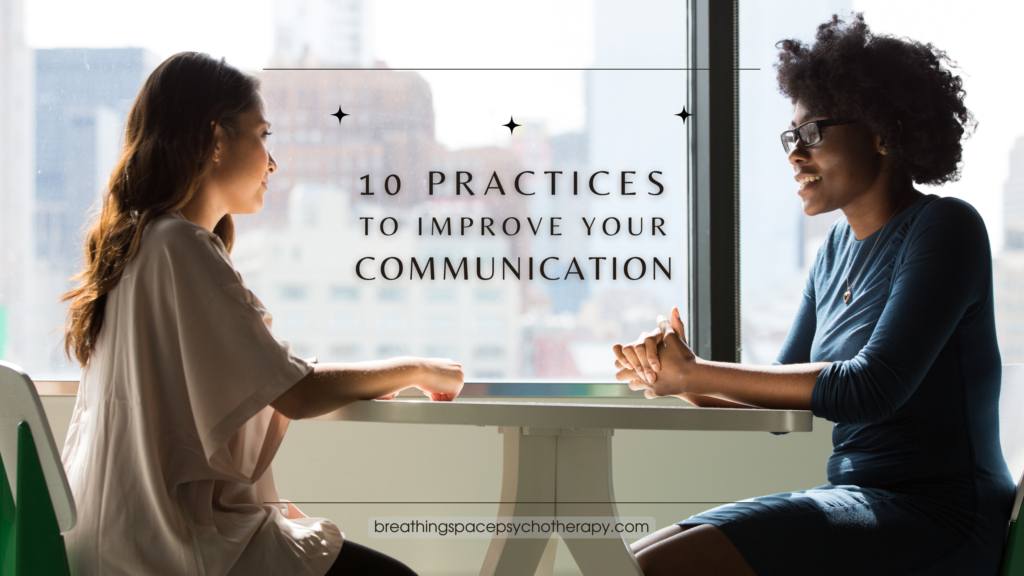Actively Listen
The first practice to improve your communication skills isn’t about talking, but rather listening.
Listen with the intent to understand, not with the intent to reply. Hold off formulating your response until your conversation partner has finished speaking. You can practice active listening by paying attention to what the other person is saying (and how they say it), asking clarifying questions, and rephrasing what they said so they know you listened, acknowledged, and understood them.
Focus on the Conversation
Have you ever started talking with someone or a group of people and it feels like no one is listening? They hum, nod, smile, or vocalize the right sounds (e.g. all the ah, ooh, eh’s) at the right moments but they’re not present in the conversation—they’re not actively listening. Maybe they’re scrolling through social media or mentally scheduling their weekend.
Unless what you’re doing on your phone is relevant to the conversation, try to put your phone aside, and don’t text, or mindlessly scroll through social media.
Ask Open-Ended Questions
If you only use yes/no questions, the conversation can quickly fall and become stagnant. Instead, try asking open-ended questions by using the “wh-” words (e.g. who, what, where, when, why) and “how.” Don’t settle for just one question either, ask follow-up questions.
Build your communication skills more by practicing your questioning skills.
Learn Body Language and Delivery
Communication is not just the content of what you’re saying; it is also the delivery—how you communicate your message using tone and body language.
Most body language tips will tell you eye contact is essential to showing someone you’re engaged in the conversation; however, you don’t need eye contact to show someone you’re listening to them. You can use other body language cues (such as facing your conversation partner or nodding along to them), or you can use the strategies we explored in our first practice: actively listen.
To learn more about the how-to’s of powerful speaking, check out this TED talk by Julian Treasure.
Let It Go
You may have a great question, a witty comment, or an inspiring line, but it no longer fits the context. Holding onto it would take mental capacity and distract you from the conversation (remember to stay focused), and to say it would interrupt the flow. Instead, you need to let it go.
Clear and Concise
Be brief. Don’t give exhausting details if they don’t benefit your message. Too many details can confuse the other person and you’ll run the risk of losing your point in the fluff.
Limit the jargon. This means you’ll have to know your audience (i.e. your conversation partner). If the other person has to wade through specialized, technical, or pompous words and make mental leaps to understand your sentences, your conversation partner and message will become lost. So, if you think they might not know the word, then don’t use it. Instead, translate the jargon in a way your partner will understand.
Use active voice. Active voice means that the subject is the actor and the object receives the action. Meanwhile, passive voice means that the subject receives the action. Take these examples:
Passive: Mistakes were made.
Passive: Mistakes were made by me.
Active: I made a mistake.
Most often, the passive voice withholds vital information, hides the actor, and draws out sentences, which is why the passive voice is often deemed weak. Passive sentences can be confusing or lead to misunderstandings. Using the active voice will make your message clearer, stronger, and more direct.
Be Assertive by using W.I.N. Statements
Being assertive is not the same as being aggressive. Aggressive communication (be it verbal or nonverbal) seldom benefits a conversation: your message will become lost in the conversation because aggression makes people feel reactive and defensive. Being assertive means setting your boundaries and saying “no” to tasks or responsibilities you don’t have the time or energy for. Next time you’re discussing important matters with your family, friends, or colleagues, use the W.I.N. statement:
When you [behavior we don’t like]
I feel [express feeling/thought]
I Need [specify change]
(taken from free–therapy’s post on Tumblr)
Be Honest and Direct (but Empathetic)
If you don’t understand something in the conversation or you think you’re misinterpreting them, tell your conversation partner you don’t understand and ask them to clarify. Don’t pretend to know something you don’t; you’re not dumb for not knowing and asking them to explain.
Similarly, if someone tells you they don’t understand what you mean, it may be easy to become frustrated. If you’re struggling to find a way to explain or if you need to step away from the conversation to process, tell them.
It’s important to note, however, that being honest and direct does not mean you are blunt and rude. Being empathetic and honest means you have an open mind, acknowledge the other person’s experience even if you disagree with them, and use sensitive language that doesn’t accuse or hurt the other person.
Emotional Validation
Emotional validation is the process of accepting and acknowledging someone else’s feelings. This doesn’t mean you agree with the other person or subject yourself to being treated poorly, and it is not a matter of who is “right.” You don’t have to understand the other person’s reasoning to validate their feelings. Validating someone’s feelings can be comforting and help people feel acknowledged.
To learn more about emotional validation, check out this article.
Practice Self-Awareness
Pay attention to your reactivity during conversations. Do you find yourself interrupting the other person? Replying before you’ve had time to process? Using accusatory language or emotionally charged words? Note your reactions and identify the areas in your communication skills that you want to improve.
A technique you can use to practice self-awareness and track your progress is to journal.






